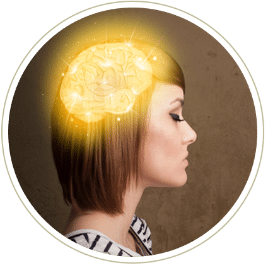The diversity of therapeutic approaches offered at both our residential and outpatient mental health treatment facilities allows our clinicians to customize treatment plans based on each person’s unique needs and preferences. Different individuals may respond better to one type of therapy over another, which is why having a variety of options ensures that more people will get effective and appropriate mental health care.
INDIVIDUAL & GROUP THERAPY
The Enterhealth Difference

Therapies & Techniques Offered at Enterhealth
Various types of therapy, including individual, group, family, and marital therapy, are essential components of mental health treatment because they offer diverse and tailored approaches to addressing different aspects of mental health and well-being.
Each type of therapy serves a unique purpose and can be effective for specific individuals or situations. The following is a non-comprehensive list of therapies and therapeutic techniques offered at our residential and outpatient mental health treatment facilities.
Individual Therapy
Individual therapy provides a one-on-one setting where a person can discuss their unique concerns, challenges, and experiences. This personalized approach allows therapists to deeply understand the individual’s background, thoughts, feelings, and behaviors.
Individual therapy offers a confidential environment where individuals can freely express their thoughts and emotions without fear of judgment or disclosure.
Therapists can tailor interventions specifically to an individual’s needs, which is crucial for addressing issues such as anxiety, depression, trauma, and personal growth.
Group Therapy
Group therapy brings together individuals who share similar challenges, fostering a sense of belonging and connection. Participants can gain support from others who understand their experiences.
Group therapy exposes individuals to diverse viewpoints and coping strategies. Hearing about others’ successes and challenges can provide valuable insights and new approaches to managing their own struggles.
Group therapy often involves skill-building exercises and role-playing, helping participants practice communication, assertiveness, and interpersonal skills.
Family Therapy
Family therapy views individuals as part of interconnected systems. It addresses family dynamics and communication patterns, recognizing that family relationships significantly impact mental health.
Family therapy focuses on resolving conflicts within the family unit, which can alleviate stressors that contribute to or exacerbate mental health issues.
By involving family members, therapy can address not only an individual’s concerns but also the overall family environment, fostering healthier relationships and support networks.
Marital Therapy
Marital therapy focuses on enhancing communication and conflict resolution skills between partners. This can lead to better understanding and decreased tension within the relationship.
Marital therapy helps couples strengthen their emotional connection and intimacy, contributing to improved overall well-being for both partners.
Couples often face shared challenges, such as parenting, finances, and life transitions. Marital therapy provides a platform to collaboratively address these concerns.
Rational Emotive Behavioral Therapy (REBT)
Rational Emotive Behavior Therapy (REBT) operates on the premise that our emotional and behavioral disturbances are not directly caused by events themselves but by our beliefs about those events. Central to REBT is the ABC model: A represents the Activating Event; B denotes the Belief about the event; and C stands for the emotional and behavioral Consequence resulting from the belief. Instead of external events causing distress, it’s our interpretation and perception of them that triggers our emotional and behavioral reactions.
In REBT, therapists work with clients to identify, challenge, and replace their irrational beliefs with more rational ones, promoting emotional well-being and constructive behaviors. This is done through techniques like Disputation of Irrational Beliefs, where the validity of the beliefs is actively questioned. Additionally, Cognitive Homework, Behavioral Interventions, and Emotive Techniques are employed to ensure that clients internalize and practice these new rational beliefs in various life situations.
Dialectic Behavioral Therapy (DBT)
Dialectical Behavior Therapy (DBT) integrates cognitive-behavioral techniques with concepts of distress tolerance, acceptance, and mindfulness. It emphasizes skill-building in four key areas: mindfulness (staying present in the moment), emotion regulation (managing and changing intense and problematic emotions), distress tolerance (accepting and tolerating distress without making it worse), and interpersonal effectiveness (navigating and maintaining relationships). Central to DBT is the principle of dialectics, which seeks a balance between acceptance and change, helping individuals reconcile opposites to build a more fulfilling life.
Cognitive Behavioral Therapy (CBT)
Cognitive Behavioral Therapy (CBT) operates on the principle that our thoughts, feelings, and behaviors are interconnected and that changing maladaptive thoughts can lead to changes in feelings and behaviors. By identifying and challenging irrational or distorted thought patterns, individuals can gain a clearer perspective and develop healthier behaviors and coping strategies. CBT emphasizes the collaborative effort between therapist and patient, the structured nature of the sessions, and often includes homework assignments to reinforce learning and practice new skills in real-world settings.
Trauma-Focused Therapy
Trauma-Focused Therapy is centered on understanding, addressing, and processing memories and emotions associated with traumatic experiences. The therapy emphasizes the identification of trauma-related symptoms, challenging maladaptive beliefs related to the trauma, and developing coping mechanisms to manage distressing memories and reactions.
Through a structured approach, individuals are supported in confronting and reprocessing their traumatic memories in a safe environment, allowing them to integrate these experiences and reduce the hold they have on their current emotions, thoughts, and behaviors.
Mental Health Education
Mental health education aims to raise awareness of mental health issues, reduce stigma, and promote psychological well-being. It provides individuals with knowledge about various mental health conditions, their symptoms, and available treatments, emphasizing the importance of early intervention and self-care. Through a combination of information dissemination, skill development, and experiential learning, mental health education empowers individuals to recognize signs of mental distress in themselves and others, seek appropriate support, and foster resilience and positive coping strategies in various life situations.
Mindfulness & Mind-Body Connection
Mindfulness & Mind-Body Connection therapy emphasizes the cultivation of present-moment awareness and the recognition of the interrelationship between one’s mental and physical states. Through practices such as meditation, deep breathing, and body scanning, individuals learn to observe their thoughts, emotions, and bodily sensations non-judgmentally, without trying to change, resist, or avoid them.
This heightened self-awareness fosters a deeper understanding of one’s reactions and promotes self-regulation, reducing stress and enhancing overall well-being. By bridging the mind and body, this approach helps individuals develop a harmonious connection, leading to improved emotional, mental, and physical health.
Solution-Focused Therapy
Solution-Focused Therapy (SFT) centers on identifying and amplifying an individual’s existing strengths and resources rather than delving deeply into underlying problems or past issues. The therapy is future-oriented, helping clients envision their desired outcomes and delineating the steps needed to achieve those goals. By emphasizing solutions and potential rather than problems, SFT fosters a sense of hope and motivation. Through a series of specific questions and conversations, therapists assist clients in recognizing and harnessing their own abilities and resources to bring about positive change in their lives.
Exposure Therapy
Exposure Therapy is grounded in the systematic and gradual exposure of an individual to feared stimuli or situations, with the goal of reducing the emotional distress or avoidance behavior associated with them. By repeatedly confronting the feared object or context in a controlled and safe environment, either in imagination or reality, the individual learns to desensitize their emotional response and weaken conditioned fear associations. Over time, this process helps to decrease anxiety and avoidance, enabling individuals to confront and manage previously distressing situations with increased confidence and reduced distress.
Eye Movement Desensitization Reprocessing (EMDR)
Eye Movement Desensitization Reprocessing (EMDR) is a therapeutic technique designed to facilitate the processing of traumatic memories and reduce their lingering impact. The approach involves the client recalling distressing events while simultaneously undergoing bilateral sensory input, typically in the form of guided eye movements.
The dual attention on memory and sensory stimulation is believed to aid in the reprocessing of traumatic information. Over successive sessions, the distress associated with the traumatic memories decreases, allowing the memories to integrate into the client’s mental schema in a less disturbing manner, thus promoting healing and resilience.
Somatic Therapy
Somatic Therapy is anchored in the understanding that the body and mind are intrinsically connected and that physical manifestations can reflect psychological states. Recognizing that trauma and emotional stress can be stored in the body, this therapeutic approach focuses on bodily sensations and somatic experiences to facilitate emotional processing and healing.
Through techniques such as breathwork, movement, and guided body awareness, clients are encouraged to tune into their bodily sensations, thereby releasing stored tension and trauma. By fostering a deeper connection and awareness between the body and mind, Somatic Therapy supports holistic healing and integration of emotional experiences.
Family-Systems Therapy
Family Systems Therapy operates on the principle that an individual’s behavior and well-being are intricately connected to the dynamics of their family system. Rather than viewing problems as confined to one family member, this therapeutic approach considers issues as systemic, arising from the interactions and relational patterns within the family unit.
Family Systems Therapy aims to identify and modify these patterns, promoting understanding, communication, and healthier functioning among family members. By addressing the family as an interconnected system, the therapy seeks to bring about collective change, where shifts in one part of the system can lead to positive changes throughout.
Person-Centered Therapy
Person-centered therapy is rooted in the belief that individuals have an inherent capacity for self-understanding and growth. This therapeutic approach emphasizes creating a non-judgmental, empathetic, and congruent therapeutic environment where clients feel valued and understood.
By offering unconditional positive regard, the therapist fosters a safe space where clients can explore and express their feelings and thoughts without fear of judgment. Through this supportive relationship, clients are empowered to discover their own solutions, enhance self-awareness, and actualize their potential, aligning more closely with their true selves.
Structural Therapy
Structural Therapy focuses on understanding and reshaping family organization and dynamics. It operates on the premise that patterns of interactions within a family can lead to challenges for individual members or the family as a whole. The therapist, in this approach, actively engages with family members to confront and change these patterns, restructuring the family’s hierarchy and boundaries to improve its overall functionality.
By identifying and altering the underlying structures that perpetuate dysfunction, the therapy aims to establish a more balanced and supportive family environment, promoting healthier interactions and well-being for all members.
